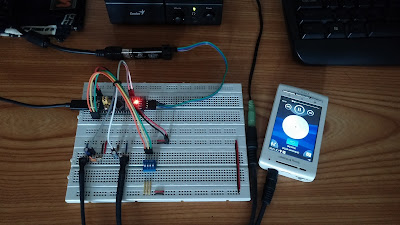This project is the application of FFT algorithm from my previous post. I made an audio spectrum analyzer project using ARM Cortex-M3 (STM32F013C8) and LED matrix 8x8. I used 16 point FFT. 16 point FFT will produce 16 point frequency spectrum. I only display the frequency spectrum from index 1 to 8 on LED matrix 8x8. Index 0 of frequency spectrum (DC signal) is not displayed. Index 9 to 15 of frequency spectrum (symmetrical frequency) is also not displayed.
My audio sampling rate is 35.15kHz, but the frequency sampling of FFT sample is 35.15kHz/2=17.5kHz. So, the maximum frequency domain
signals that can be displayed is up to 8.75kHz (Nyquist's theorem) and
the resolution is 8.75kHz/8≈1kHz.




